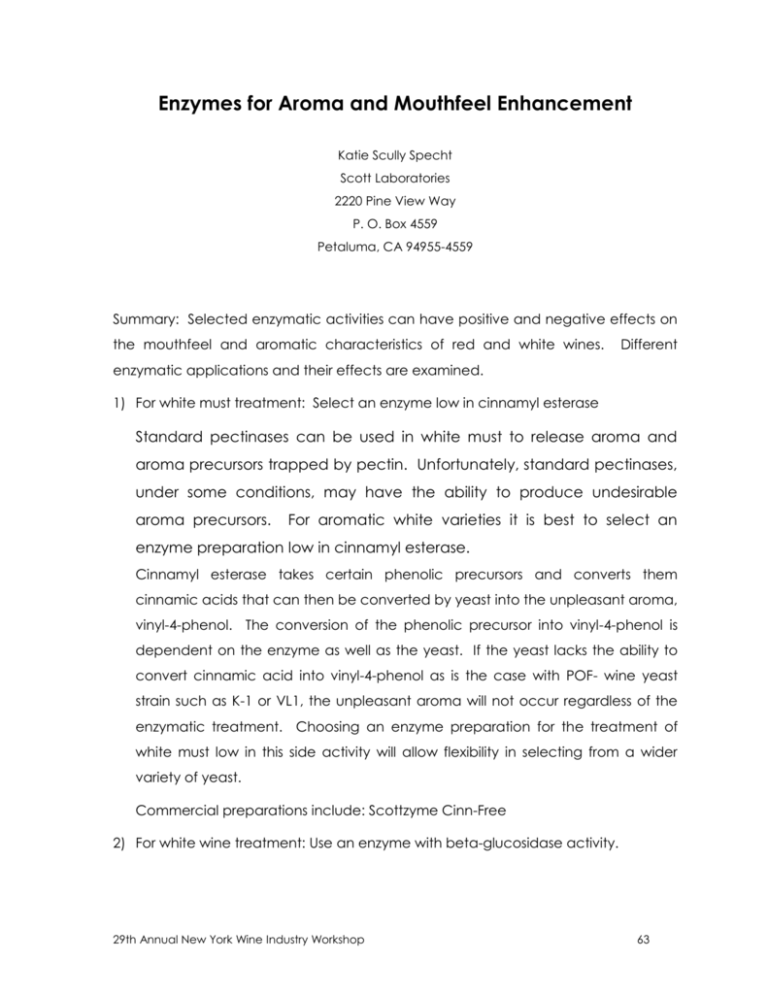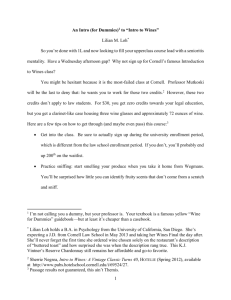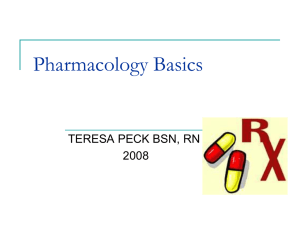Enzymes for Aroma and Mouthfeel Enhancement
advertisement

Enzymes for Aroma and Mouthfeel Enhancement Katie Scully Specht Scott Laboratories 2220 Pine View Way P. O. Box 4559 Petaluma, CA 94955-4559 Summary: Selected enzymatic activities can have positive and negative effects on the mouthfeel and aromatic characteristics of red and white wines. Different enzymatic applications and their effects are examined. 1) For white must treatment: Select an enzyme low in cinnamyl esterase Standard pectinases can be used in white must to release aroma and aroma precursors trapped by pectin. Unfortunately, standard pectinases, under some conditions, may have the ability to produce undesirable aroma precursors. For aromatic white varieties it is best to select an enzyme preparation low in cinnamyl esterase. Cinnamyl esterase takes certain phenolic precursors and converts them cinnamic acids that can then be converted by yeast into the unpleasant aroma, vinyl-4-phenol. The conversion of the phenolic precursor into vinyl-4-phenol is dependent on the enzyme as well as the yeast. If the yeast lacks the ability to convert cinnamic acid into vinyl-4-phenol as is the case with POF- wine yeast strain such as K-1 or VL1, the unpleasant aroma will not occur regardless of the enzymatic treatment. Choosing an enzyme preparation for the treatment of white must low in this side activity will allow flexibility in selecting from a wider variety of yeast. Commercial preparations include: Scottzyme Cinn-Free 2) For white wine treatment: Use an enzyme with beta-glucosidase activity. 29th Annual New York Wine Industry Workshop 63 Aromatic grape varieties contain large amounts of ‘free’ and ‘bound’ terpenols. Terpenols in their ‘free’ form can be described as ‘fruity’ and ‘floral’. They are also one of the compounds responsible for enhancing varietal characteristics. ‘Bound’ terpenols are non-volatile precursors of these aromatic compounds. The ratio of ‘free’ and ‘bound’ terpenols depends on the fruit variety. Using an enzyme that is able to cleave ‘bound’ terpenols from the sugar that binds them will result in more aromatic wines. Treatment with a beta-glucosidase preparation is most effective in wine because this enzyme activity is inhibited by glucose. Carefull monitoring of the aroma development is important when using beta-glucosidase preparations since overtreatment can result in bitter wines. Yeast strains, such as the VL1, have naturally high activities of the beta-glucosidase that are not inhibited by glucose. Commercial preparations include: AR2000 3) For accelerated maturing of white and red wine on lees: Use an enzyme with beta-glucanase activity. Beta-glucanase activity facilitates the release of polysaccharides from yeast. Polysaccharides form complexes with certain polyphenolic components of red wines contributing to fuller, more rounded wines. In white wines studies show that the use of a beta-glucanase leads to significant and faster increase in the amount of polysaccharides from the yeast cell wall. The effect of this enzyme treatment is a shorter and more desirable sur lie aging. It should be noted that beta-glucanase preparations are commonly used in other countries, however, they are currently not approved for use in wine by the ATF. These preparations are sourced from Tricoderma and only enzymes coming from Aspergillus niger have ATF approval. 4) For better mouthfeel and improved aromas in red wines: Use enzyme preparations selected for their ability to enhance color, tannins and polyphenols. There are several enzyme preparations available that improve the characteristics of red wines when used during fermentation. Some preparations are pectinases with acid-stable protease side activities and other preparations 29th Annual New York Wine Industry Workshop 64 are pectinases with hemicellulase and cellulase side activities. Before an enzyme is selected for use in reds, it must be pre-screened by the supplier for its ability to improve (or at least not destroy color). Standard preparations high in glycosidase (sugar cleaving) activities will destroy anthocyanin stability and lead to color loss. Although increased color is not always observed in treatment with so called ‘color enzymes’, there generally is a positive effect in the mouthfeel and aroma of treated wines. The side activities in these preparations facilitate the early release of less aggressive tannins that lead to less astringent wines. The release of anthocyanins, polysaccharides and tannins by direct and indirect action result in bigger, more balanced mouthfeel. Some preparations have been shown to limit the extraction of C6 compounds that are responsible for herbaceous notes. Commercial preparations include: (a) Scottzyme Color PRO (contains protease); (b) Scottzyme Color X and Lallzyme EX (contains cellulase and hemicellulase) 29th Annual New York Wine Industry Workshop 65







